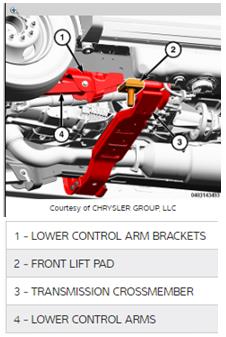In many of our articles at the beginning of a procedure the first step indicates to jack up or lift the vehicle with a link directing you to “Lifting Procedure”. I’m sure if you are like me; I usually just grabbed the jack and a pair of stands and went at it. These days though with battery boxes, diesel particulate filters, SCR tanks and other accessories mounted to the frame it is a completely different story. Upfitters make use of all the space afforded them on the frame and space is tight and limited. At the various commercial vehicle and truck shows I attend, Upfitters quibble with OEM’s over inches available on the frame. Upfitters are the companies that install all the aftermarket accessories on trucks such as boxes, beds, tool boxes, cranes, snow plows, etc.
So why not take a minute to check it out and make sure you are using a safe lifting point? A quick mouse click on the reference provided will indicate where the OEM’s have determined the safe lifting points to be located on a particular vehicle. Most graphics even identify the safe lifting points along with component locations and identification.

As trucks are generally built to order components may be located in different places on a same model truck. Diesel Particulate Filters are usually available in different configurations on a same model truck as well as the Selective Catalytic Reduction tanks and piping. Never hurts to play it safe and have a quick look.
I did some research on jack lift failure accidents and found this information from the National Highway Traffic Safety Administration. While this is older information, it still provides some eye opening statistics.

Time is money when you are working flat rate but maybe some of these accidents could have been prevented by taking the little extra time it takes to research the jack and lifting information. Take advantage of all the information provided in Truck Series truck repair software to lift that truck safely and prevent a possible accident. Remember it never hurts to ‘Play It Safe!”






